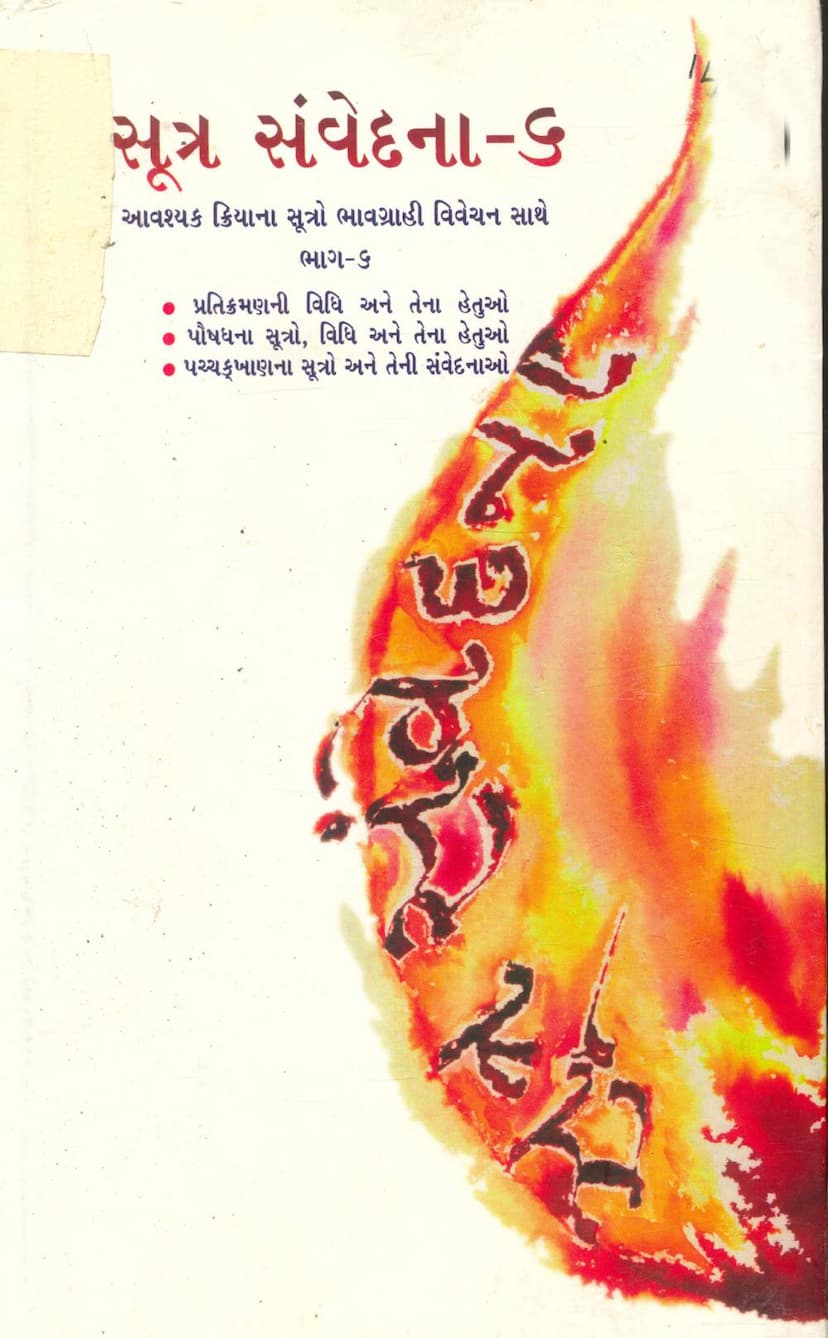Sutra Samvedana Part 06
Added to library: September 2, 2025

Summary
Certainly, here's a comprehensive summary of the Jain text "Sutra Samvedana Part 06" by Prashamitashreeji, based on the provided pages and catalog link:
Book Title: Sutra Samvedana – 6 Author: Sadhvi Shree Prashamitashreeji Publisher: Sanmarg Prakashan
Catalog Link: https://jainqq.org/explore/005840/1
Overall Theme:
"Sutra Samvedana – 6" is the sixth volume in a series dedicated to explaining the profound meanings and practical applications of Jain scriptures, particularly focusing on essential Jain practices. This particular volume delves deeply into the "Aavashyak Kriya" (essential daily practices), providing a contemplative commentary ("bhavagrahi vivechan") on the underlying sentiments and spiritual intentions behind these rituals. The book aims to transform mere ritualistic performance into a deeply felt spiritual experience.
Key Topics Covered:
As indicated by the table of contents and chapter titles, this volume is structured into three main sections:
-
Section 1: Pratitkraman (Repentance/Confession) - Vidhi (Procedure) and Hetu (Purposes)
- This section meticulously details the procedural steps of "Pratikraman," a crucial Jain ritual involving self-reflection, confession of sins, and seeking forgiveness.
- It elaborates on the specific procedures for both the daily ("Deavsik") and nightly ("Ratrik") Pratikraman.
- Crucially, it explains the underlying "hetu" or purposes behind each step of Pratikraman. This includes understanding why each action is performed, focusing on its role in purifying the soul, fostering equanimity, and mitigating karma.
- The text emphasizes the "samvedana" or the inner emotional and spiritual experience that should accompany these actions. This involves cultivating feelings of repentance, humility, and a desire for spiritual upliftment during the ritual.
- It covers various aspects of Pratikraman, including the significance of Samayik (meditative equanimity), Dev Vandan (worship of deities), Guru Vandan (respect for spiritual guides), Sajjhay (scriptural recitation), and the core act of Pratitkraman itself.
-
Section 2: Paushadh (Fasting/Observance Day) - Sutras (Verses), Vidhi (Procedure), and Hetu (Purposes)
- This section focuses on "Paushadh," a significant Jain observance day characterized by fasting and increased spiritual discipline.
- It presents the specific "sutras" (verses or mantras) used during Paushadh.
- It details the "vidhi" or the proper way to observe Paushadh, outlining the rules and regulations to be followed.
- The "hetu" or the underlying purposes of Paushadh are explained, emphasizing its role in controlling desires, purifying the body and mind, and cultivating spiritual detachment.
- The text also touches upon related practices like "Mandala" (ritualistic diagrams) and "Santhara-Porisi" (specific sleeping arrangements and practices for monks/ascetics, often related to the final vow of renunciation).
-
Section 3: Pachchakkhan (Vows/Resolutions) - Sutras and Samvedana (Sentiments/Experiences)
- This section deals with "Pachchakkhan," the taking of specific vows or resolutions for a limited or indefinite period.
- It presents the "sutras" associated with taking Pachchakkhan, which can range from abstaining from certain foods to more rigorous vows.
- The "Samvedana" aspect here focuses on the inner resolve, the emotional commitment, and the spiritual growth experienced by the practitioner while adhering to these vows.
- The text likely explains various types of Pachchakkhan, such as those related to food intake (e.g., Ekasanu, Ayambil), speech, activities, and sensory indulgences.
Key Principles and Emphasis:
- Bhavagrahi Vivechan (Contemplative Commentary): A central tenet of this volume is to go beyond the literal meaning of the sutras and explore the deeper, emotional, and spiritual significance ("bhava") behind the actions. The goal is to connect with the inner experience of these practices.
- Transforming Ritual into Experience: The book aims to guide practitioners from performing rituals mechanically to engaging in them with full awareness, devotion, and understanding of their purpose, thereby transforming them into powerful spiritual disciplines.
- Purposeful Action: The emphasis is placed on understanding the "hetu" (purpose) behind each action in the Aavashyak Kriya, Pratikraman, Paushadh, and Pachchakkhan, ensuring that the practitioner engages in these acts with conscious intent.
- Discipline and Control: The text highlights the Jain emphasis on self-discipline, control over senses and desires, and the gradual purification of the soul through rigorous adherence to vows and practices.
- Spiritual Growth: Ultimately, the book serves as a guide for spiritual growth, helping individuals deepen their understanding and practice of Jain principles, leading to greater peace, self-awareness, and progress on the path to liberation.
In essence, "Sutra Samvedana – 6" is a guide to the inner life of Jain practices, encouraging a mindful and devotional approach to repentance, observance days, and vows, aiming to infuse these actions with profound spiritual meaning and transform them into pathways for soul purification and ultimate liberation.